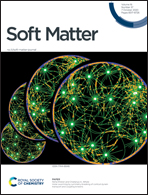Desorption energy of soft particles from a fluid interface
Abstract
The efficiency of soft particles to stabilize emulsions is examined by measuring their desorption free energy, i.e., the mechanical work required to detach the particle from a fluid interface. Here, we consider rubber-like elastic as well as microgel particles, using coarse-grained molecular dynamics simulations. The energy of desorption is computed for two and three-dimensional configurations by means of the mean thermodynamic integration method. It is shown that the softness affects the particle–interface binding in two opposing directions as compared to rigid particles. On the one hand, a soft particle spreads at the interface and thereby removes a larger unfavorable liquid–liquid contact area compared to rigid particles. On the other hand, softness provides the particle with an additional degree of freedom to get reshaped instead of deforming the interface, resulting in a smaller restoring force during the detachment. It is shown that the first effect prevails so that a soft spherical particle attaches to the fluid interface more strongly than rigid spheres. Finally, we consider microgel particles both in the swollen and in the collapsed state. Surprisingly, we find that the latter has a larger binding energy. All results are rationalised using thermodynamic arguments and thereby offer detailed insights into the desorption energy of soft particles from fluid interfaces.



 Please wait while we load your content...
Please wait while we load your content...